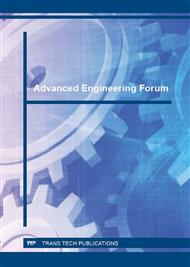[1]
K. Otsuka and C.M. Wayman, Shape memory materials. Cambridge, New York, Cambridge University Press; (1998).
Google Scholar
[2]
Ying Zhao, Minoru Taya and HiroshiIzui, Study on energy absorbing composite structure made of concentric NiTi spring and porous NiTi, Int. J. Solids Struct. 43 (2006) 2497-2512.
DOI: 10.1016/j.ijsolstr.2005.06.043
Google Scholar
[3]
Muhammad A Qidwai, Virginia G DeGiorgi, Numerical assessment of the dynamic behavior of shape memory alloy composite, Smart Mater. Struct. 13 (2004) 134-145.
DOI: 10.1088/0964-1726/13/1/015
Google Scholar
[4]
Dana M. Elzay, AarashY.N. Sofia andHaydn N.G. Wadley, A shape memory based multifunctional structural actuator panel, Int. J. Solids Struct. 42 (2005) 1943-(1955).
DOI: 10.1016/j.ijsolstr.2004.05.034
Google Scholar
[5]
Seung-Baik Kang, Kang-Sup Yoon, Ji-Soon Kim, Tae-Hyun Nam and Victor E. Gjunter, In vivo results of porous Ti-Ni shape memory alloy: bone response and growth, Mater. Trans. 43 (2002) 1045-1048.
DOI: 10.2320/matertrans.43.1045
Google Scholar
[6]
LorenzaPetrini and Francesco Migliavacca, Biomedical applications of shape memory alloys". J. Metallurgy, doi: 10. 1155/2011/501483.
Google Scholar
[7]
DanielaTarnită, D. N. Tarnită, N. Bizdoacă, I. Mindrilă and MirelaVasilescu, Properties and medical applications of shape memory alloys, Romanian J. Morphology and Embriology50 (1) (2009) 15-21.
Google Scholar
[8]
S. Rhalmi, M. Odin, M. Assad, M. Tabrizian, C.H. Rivard, L.H. Yahia, Hard soft tissue and invitro cell response of nickel titanium: a biocompatibility evaluation, Biomed. Mater. Eng. 9 (1999): 151-62.
Google Scholar
[9]
R.A. Ayers, S.J. Simske, T.A. Batman, A. Petkus, R.L. C Sachdevaand V.E. Gyunter, Effect of nitinol implantporosity on cranial bone ingrowth and apposition after 6 weeks, J. Biomed mater. Res. 45(1999) 42-47.
DOI: 10.1002/(sici)1097-4636(199904)45:1<42::aid-jbm6>3.0.co;2-q
Google Scholar
[10]
AmpikaBansiddhi and David C. Dunand, Shape memory Ni-Ti foams produced by solid state replication with NaF, Intermetallics 15 (2007) 1612-1622.
DOI: 10.1016/j.intermet.2007.06.013
Google Scholar
[11]
Christian Greiner, Scott M. Oppenheimer and David C. Dunand, High strength, low stiffness, porous NiTi with superelastic properties, David C Dunand, ActaBiomateri. 1 (2005) 705-716.
DOI: 10.1016/j.actbio.2005.07.005
Google Scholar
[12]
A. Bansiddhi, T.D. sargeant, S.I. Stupp and D.C. Dunand, Porous NiTi for bone implants: A review, ActaBiomater, 4 (2008) 773-82.
DOI: 10.1016/j.actbio.2008.02.009
Google Scholar
[13]
A. Bansiddhi and D.C. Dunand, Shape-memory NiTi foams produced by replication of NaCl space-holders, ActaBiomaterialia4 (2008) 1996-(2007).
DOI: 10.1016/j.actbio.2008.06.005
Google Scholar
[14]
B. Yuan, X P Zhang, C Y chung, M.Q. Zeng.M. Zhu, A comparative study of the porous TiNi shape memory alloys fabricated by three different processes, Metall. Mater. Trans. A 37A (2006) 755-760.
DOI: 10.1007/s11661-006-0047-5
Google Scholar
[15]
B. Bertheville, Porous single-phase NiTi processed under Ca reducing vapor for use as a bone graft substitute, Biomaterials27 (2006) 1246.
DOI: 10.1016/j.biomaterials.2005.09.014
Google Scholar
[16]
ZarikAydog˘ Mus¸ and S¸akirBor, Enhanced sintering of TiNi shape memory foams under Mgvapour atmosphere, Metall. Mater. Trans. A 43A (2012) 5173-5180.
DOI: 10.1007/s11661-012-1350-y
Google Scholar
[17]
S. K. Sadrnezhadd, H. Arami, H. Keivan and R. Khalifezadeh, Powder Metallurgical Fabrication and Characterization of Nanostructured Porous NiTi Shape Memory Alloy, Mater. Manuf. Process 21 (2006) 727-735.
DOI: 10.1080/10426910600727882
Google Scholar
[18]
Anselm J. Neurohr and D. C. Dunand, Mechanical anisotropy of shape memory NiTi with two dimensional networks of microchannels, Acta mater. 59(2011) 4616-4630.
DOI: 10.1016/j.actamat.2011.04.007
Google Scholar
[19]
Yuya Arakawa, Makoto Kobashi and NaoyukiKanetake, Effect of Elemental powder size on foaming behavior of NiTi alloy made by Combustion shynthesis, Materials 5 (2012) 1267-1274.
DOI: 10.3390/ma5071267
Google Scholar
[20]
ShuilinWua, XiangmeiLiu K.W.K. Yeung, Tao Hu, ZushunXu, Jonathan C.Y. Chung b, and Paul K. Chu , Hydrogen release from titanium hydride in foaming of orthopedic NiTi scaffolds, ActaBiomater. 7 (2011) 1387-1397.
DOI: 10.1016/j.actbio.2010.10.008
Google Scholar
[21]
P. Bassani, E. Bassani, A. Tuissi, P. Giuliani and C. Zanotti, NonequiatomicNiTi alloy Produced by self propagating high temperature synthesis, J. Mater. Eng. Perf. 23(2014) 2373-2378.
DOI: 10.1007/s11665-014-1055-z
Google Scholar
[22]
Y Zhao, M. Taya, Y.S. Kanga and A. Kawasaki, Compression behavior of porous NiTi shape memory alloy, Acta mater. 53 (2005) 337-343.
DOI: 10.1016/j.actamat.2004.09.029
Google Scholar
[23]
J.Y. Xiong, Y.C. Li, X.J. Wang, P.D. Hodgsona and C.E. Wen, Titanium Nickel shape memory alloy foams for bone tissue engineering, J. Mechanical Behv. Biomed. Mater. 1(2008) 269-273.
DOI: 10.1016/j.jmbbm.2007.09.003
Google Scholar
[24]
A Bansiddhiand D.C. Dunana, Processing of Ni-Ti foams by Transient Liquid phase sintering., J. Mater. EngPerf. 20 (2011) 511-516.
Google Scholar
[25]
X.K. jhao, H.B. Sun, L. Lan, J.H. huang, H. Zhang and Y. Wang, Pore structures of high-porosity NiTi alloys made from elemental powders with NaCl temporary space-holders, Mater. Lett. 63(2009)2402-2404.
DOI: 10.1016/j.matlet.2009.07.069
Google Scholar
[26]
M. L. Young, J.D. deFouw, J. Frenzel and D.C. Dunand, Cast replicated NiTiCu foams with superelastic properties, Metall. Mater. Trans. A 43A (2012) 2939-2944.
DOI: 10.1007/s11661-011-1060-x
Google Scholar
[27]
D. P Mondal, Mahesh Patel, S. Das, A.K. Jha, Hemant Jain, G. Gupta, andS. B Arya, Titanium foam with coarser cell size and wide range of porosity using different types of evaporative space holder through powder metallurgy, Mater. Des. 63(2014).
DOI: 10.1016/j.matdes.2014.05.054
Google Scholar
[28]
A. Paul and U. Ramamurty. Strain rate sensitivity of a closed-cell aluminium foam, Mater. Sci. Eng. A 281 (2000) 1-7.
Google Scholar
[29]
Lee Sungsoo, Barthelat Francois, Moldovan Nicolaie, D. EspinosaHoracio and N. G WaldleyHaydn., Deformation rate effects on failure modes of open-cell Al foams and textile cellular materials, Int. J. Solids Struct. 43 (2006) 53-73.
DOI: 10.1016/j.ijsolstr.2005.06.101
Google Scholar
[30]
C. Grabe, O.T. Bruhus, On the viscous and strain rate dependent behavior of plycrystallineNiTi, Int. J. Solids Struct. 45 (2008) 1876-1895.
Google Scholar
[31]
SanghaunKimandMaenghyo Cho, A strain rate effect of Ni-Ti shape memory alloy wire, Jpn. J. Appl. Phys. 49(2010) 1-5.
DOI: 10.1143/jjap.49.115801
Google Scholar
[32]
D.P. Mondal, M.D. Goel and S. Das, Compressive deformation and energy absorption characteristics of closed cell aluminum-fly ash particle composite foam, Mater. Sci. Eng. A 507 (2009) 102-109.
DOI: 10.1016/j.msea.2009.01.019
Google Scholar
[33]
M.D. Goel, D.P. Mondal, M.S. Yadav and S.K. Gupta, Effect of strain rate and relative density on compressive deformation behavior of aluminum cenosphere syntactic foam, Mater. Sci. Eng. A 590 (2014) 406-415.
DOI: 10.1016/j.msea.2013.10.048
Google Scholar
[34]
ISO 13314: 2011Mechanical testing of metals. Ductilitytesting. Compression test for porousand cellular metals. Geneva, Switzerland.
Google Scholar


